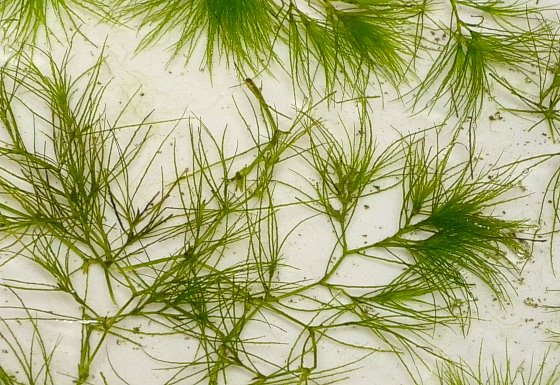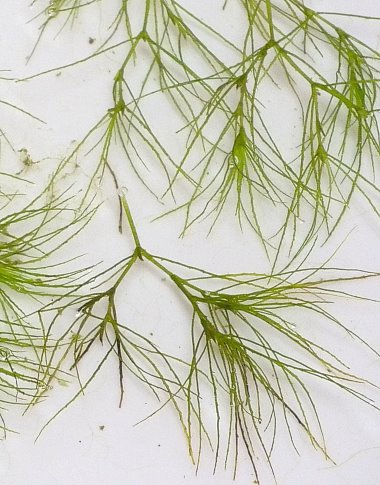 medium green, narrowly
linear, glabrous, somewhat recurved, and flexible. The leaf margins
have 10-20 teeth on each side that are minute and somewhat bristly (may
require 10x magnification to see). At the leaf bases, there are
individual sheaths about 2-3 mm. long; each sheath is truncate and
bristly-fringed on top. Sessile unisexual flowers develop from the
axils of the leaves (one flower per leaf axil); individual
plants or plant fragments can be dioecious or monoecious. Each
male flower consists of a single stamen, while each female flower
consists of a single pistil. Both types of flower are surrounded by
membranous spathes; they are about 2-3 mm. long. Individual plants can
bloom from mid-summer to early fall. Cross-pollination of the flowers
is accomplished by water currents. The female flowers are replaced by
fruits about 2-3 mm. long that are ellipsoid-oblongoid in shape,
slightly curved, and dark brown or purple at maturity; their tips have
slender beaks. Each fruit contains a single seed that is
ellipsoid-oblongoid in shape. The root system is shallow and fibrous.
This aquatic plant can spread vegetatively by the breakage of its
fragile stems; the resulting plant fragments can drift to new locations
in currents of water. It also spreads by the distribution of its seeds.
medium green, narrowly
linear, glabrous, somewhat recurved, and flexible. The leaf margins
have 10-20 teeth on each side that are minute and somewhat bristly (may
require 10x magnification to see). At the leaf bases, there are
individual sheaths about 2-3 mm. long; each sheath is truncate and
bristly-fringed on top. Sessile unisexual flowers develop from the
axils of the leaves (one flower per leaf axil); individual
plants or plant fragments can be dioecious or monoecious. Each
male flower consists of a single stamen, while each female flower
consists of a single pistil. Both types of flower are surrounded by
membranous spathes; they are about 2-3 mm. long. Individual plants can
bloom from mid-summer to early fall. Cross-pollination of the flowers
is accomplished by water currents. The female flowers are replaced by
fruits about 2-3 mm. long that are ellipsoid-oblongoid in shape,
slightly curved, and dark brown or purple at maturity; their tips have
slender beaks. Each fruit contains a single seed that is
ellipsoid-oblongoid in shape. The root system is shallow and fibrous.
This aquatic plant can spread vegetatively by the breakage of its
fragile stems; the resulting plant fragments can drift to new locations
in currents of water. It also spreads by the distribution of its seeds.Cultivation: The preference is full or partial sun and clear unpolluted water that is shallow to moderately deep (up to 20' deep). The water should be relatively low in nutrients to reduce competition from algae and other plants. Water pH can vary from mildly acidic to mildly alkaline. The bottom of the water body can consist of sand or mud. There should be protection from strong waves and water currents.
Range & Habitat: The native Thread-Leaf Naiad is an uncommon plant that is found primarily in southern Illinois (see Distribution Map). It is widely distributed in NE and north-central United States, Canada, and Eurasia. Populations of this aquatic plant may be declining because of increased turbidity and pollution of water. However, because this species is relatively small and inconspicuous, it may occur in more areas within the state than current records indicate. Habitats include sheltered inlets of lakes, ponds, upland sinkholes, and spring-fed pools of water. Thread-Leaf Naiad is usually found in higher quality wetlands. However, it is possible to find this species in sheltered ponds near developed areas if its preference for clear unpolluted water has been satisfied. In Illinois, this is one of the less aggressive species of Naiad.

Faunal Associations: The larvae of a shore fly, Hydrellia bilobifera, feed on the submerged leaves and stems of Naiad species (Najas spp.), as well as other aquatic plants; see Harms & Grodowitz (2009). Among vertebrate animals, many species of waterfowl (mainly ducks) feed on the leaves and stems of Naiad species. These waterfowl include the American Wigeon, Mallard, Gadwall, Lesser Scaup, and Common Coot (see Waterfowl Table for a more complete list of species). The latter bird is actually a rail. Turtles also feed on the foliage of these aquatic plants; this includes Chelydra serpentina (Snapping Turtle), Chrysemys picta (Painted Turtle), Emys blandingii (Blanding's Turtle), Pseudemys concinna (River Cooter), Sternotherus odoratus (Musk Turtle), and Trachemys scripta (Slider); see Lagler (1943) and Ernst et al. (1994) for more information. The foliage of Naiad species is a minor source of food for Muskrats, and it is also eaten occasionally by a freshwater fish, Lepomis macrochirus (Bluegill); see Hamerstrom & Blake (1939) and Forbes (1888) for more information.
Photographic Location: This plant was found in the shallow water of a pond near Urbana, but it was photographed indoors. A careful examination of the photos will reveal beaked fruits in some of the leaf axils.

Comments: Thread-Leaf Naiad is a delicate plant with leaves and stems that are slender and flexible. It superficially resembles other kinds of aquatic plants, but its leaves have fine bristly teeth along their margins and its sessile flowers/fruits are produced individually in the axils of the leaves. Compared to other Najas spp. (Naiads) within Illinois, Thread-Leaf Naiad has more slender leaves (only 0.1-0.3 mm. across). A weedy introduced species, Najas minor (Brittle Naiad), is somewhat similar in appearance (at least earlier in the year), but this latter species has stems and leaves that are stiff and brittle, rather than flexible. Both the scientific and common names of plants in this genus (Najas, Naiad) refer to the Water Nymphs, or Naiades, of ancient mythology. These were lesser female deities who presided over rivers, brooks, springs, and fountains.